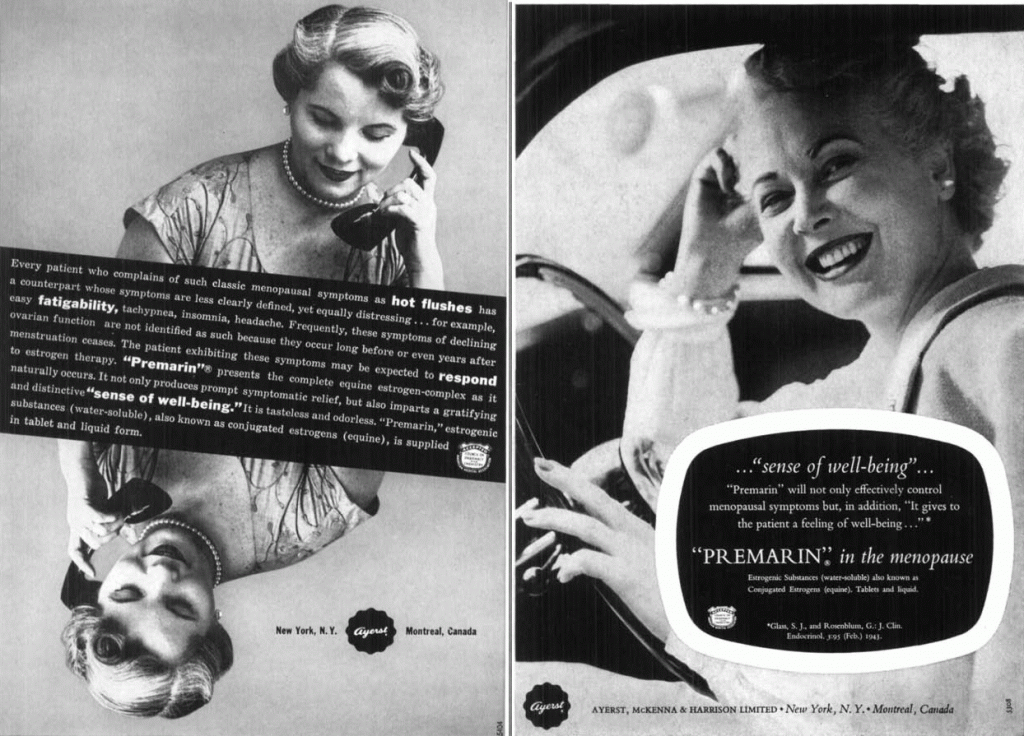Nonhormonal versus non-pharmaceutical
 HRT has suffered quite a hit in recent years and as a result, the Menopause Industrial Complex has been scrambling to find a viable replacement. And while I would like to believe in that altruism is driving the train, the cynic in me truly believes that it’s mostly profit motivated. That being said, I do admire the tenacity of industry to attempt to find a reasonable replacement for HRT (and hopefully a safer one) for women who want a fix for troublesome vasomotor symptoms — hot flashes and night sweats — and don’t want to make the effort or don’t understand how to navigate the landscape of alternative strategies.
HRT has suffered quite a hit in recent years and as a result, the Menopause Industrial Complex has been scrambling to find a viable replacement. And while I would like to believe in that altruism is driving the train, the cynic in me truly believes that it’s mostly profit motivated. That being said, I do admire the tenacity of industry to attempt to find a reasonable replacement for HRT (and hopefully a safer one) for women who want a fix for troublesome vasomotor symptoms — hot flashes and night sweats — and don’t want to make the effort or don’t understand how to navigate the landscape of alternative strategies.
However, let’s be clear: there is a distinction between nonhormonal treatments and non-pharmaceutical treatments, hence, when you start hearing about ‘nonhormonal’ options, be sure to ask what that means, because it’s likely that it means ‘not HRT,’ such as a new non-hormonal pharmaceutical alternative to HRT: LDMP, better known as low-dose paroxetine. For those of you who are unfamiliar with paroxetine, it is a type of SSRI used in the treatment of depression, panic disorder and social anxiety disorder; the popular antidepressant Paxil is a form of paroxetine.
Paroxetine is not the first antidepressant to be studied in menopausal women and you may recall that I wrote about the use of Lexapro for hot flashes about a year and a half ago. You can find that post here. However, paroxetine is the antidepressant that’s all the buzz right now, since Noven Pharmaceuticals presented two studies last week at the North American Menopause Society annual meeting. Note that it’s been reframed as ‘low-dose non-hormonal therapy for menopausal vasomotor symptoms,’ but ya still gotta call a spade a spade and what it is is an antidepressant.
Here’s what you need to know:
In one of two studies, 568 women (40+ years of age) who experienced 7 to 8 moderate or severe hot flashes on a daily basis of 50 to 60 on a weekly basis took either 7.5 mg of LDMP or placebo daily over six months. By the end of the first month (and in contrast to the study’s start), women who were taking LDMP experienced 28.9 fewer hot flashes per week (compared to 19 fewer per week for women taking placebo pills). By the third month, this increased by roughly 10 fewer per week in both groups. The severity of the hot flashes also significantly decreased. Safety wise, women taking LDMP reported nausea and bronchitis.
In the complementary study, which lasted for three months, 606 women in the same demographic took the same dose of LDMP or placebo. Decreases in mean number of flashes per week were pretty much on par with the first study (33 compared to 23.5 for placebo) and similarly, a trend towards maintaining and growing benefits were observed. Severity of hot flashes also declined but by the study’s end, were not significantly different than placebo. This time, women who took LDMP most frequently reported dizziness and fatigue.
Dr. James Simon, one of the studies’ investigators and a professor of ob/gyn at GWU School of Medicine claims that symptoms of menopause often go untreated when women are unable or unwilling to take hormone therapy, which is not entirely true. Another investigator — Dr. Andrew Kaunitz from the University of Florida College of Medicine in Jacksonville notes that if LDMP is approved by the FDA, “it could be the first nonhormonal option available for women.” Again, this statement is not entirely true. LDMP has the potential to become the first nonhormonal treatment APPROVED by FDA for vasomotor symptoms in menopausal women. There are other options out there but on the most part, they are not embraced by Western practitioners. Take note: while many Western practitioners will argue until they are blue in the face that alternative strategies have no role, are no better than placebo, and do not have evidenced-based trial data to support their use, they are simply incorrect. An unequivocal statement about every alternative strategy available to wo-man is bad medicine at best and at worst? Sheer ignorance.
Back to LDMP…LDMP appears to effectively diminish hot flashes and sweats but it is not without side effects. And while the dosage is considerably lower than full-strength antidepressants, we don’t have enough information to know if it will ultimately mimic its higher dose partner; the most common side effects reported in these trials are the very same that have been reported with Paxil. Another common side effect of Paxil that has not been explored (at least not publicly) in these trials is the effects on libido and it is a well known fact that as many women go through menopause, they experience declines in sex drive, lubrication and the ability to reach orgasm.
I say that the verdict is still out. And that based on the way that communications about this agent are being framed, that it’s about the spin. I guess that time will tell.
Read More
HRT Personalized?
Have you heard of personalized medicine? This burgeoning movement in healthcare focuses on the individual and not the masses and relies on our unique biological and genetic profiles to guide therapy choice.
With all the hullabaloo over hormone replacement therapy (HRT), mixed data about risks and benefits and a lack of a clear path for women who choose to go this route, personalized medicine might hold the answer. In fact, in an online review in Metabolism, authors are exploring the very idea that some women may be more ideally suited than others for hormone therapy. Personalized medicine may also make it possible to tailor dosing, formulation and even route of delivery to make the benefit-risk ratio, which we know has been swinging toward the negative, more balanced and favourable.
Although a recent report has come out disputing the role of hormone therapy in increasing risk for heart issues, data from the Women’s Health Study showed that compared to placebo, women who took combination hormones were 24% more likely to develop heart disease (i.e. heart attack or coronary death), up to 40% liklier to have a stroke and twice as likely to develop a blood clot in the lungs. Women who took estrogen only had almost a 40% increased risk for stroke and a trend towards an increased risk for developing a clot in the arteries leading to the lungs. Yet, these results might not be applicable to all as research suggests that factors such as age, time since the onset of menopause, LDL and other cholesterol levels and the presence or absence of metabolic disease may be able to help identify women who are better versus worse candidates for HRT (and likely or less likely to have elevated risk). Moreover, emerging evidence suggests that women who already have an elevated risk for stroke should either avoid systemic hormone therapy or choose a safer delivery method, e.g., a transdermal (through the skin).
A number of experts believe that using lower doses of hormones, bioidentical compounds, and going the transdermal route may very well change the benefit/risk ratio as well, primarily due to reduce blood levels of circulating hormones or as with transdermals, the fact that the drug doesn’t pass through the liver. In some cases, however, the data are scant and randomized clinical trial evidence, also referred to in medical circles as evidenced-based medicine, may be lacking. Still, I do believe that personalized medicine may hold the key for millions of women who can’t find relief through alternative strategies or simply desire more immediate relief. Perhaps some of these very factors that researchers are exploring will remove some of the roadblocks. Meanwhile, pay attention to the variety of factors that may the golden ticket — factors like age, time since menopause, heart health, existing breast cancer risk, biomarkers in the blood and genetic predisposition. Who knows? HRT personalized might be just around the corner.
Read MoreHormone Replacement…for that sense of wellbeing
I ran across a piece in yesterday’s New York Times highlighting that Roche Pharmaceuticals was closing its Nutley, NJ plant where it first developed Valium and its predecessor, Librium. In it, writer Robin Marantz Henig notes that these two agents were actually marketed to physicians as medications that could help individuals feel ‘normal,’ (that is, if normal means walking around in a pleasant fog that masks reality). Henig writes “As Roche closes its New Jersey headquarters, it plans to open a smaller research facility in Manhattan in late 2013, part of a wave that city officials hope will turn New York into a biotech mecca. The company’s transition reminds us of a phenomenon that’s become so common we no longer even think of it as weird: the oxymoronic attainment, through using drugs to make you feel more like yourself, of an artificially induced normal.”
This thought got me wondering if we had actually gone full circle, where the ultimate goal of treatments for menopausal symptoms are to help a woman feel normal again without addressing underlying issues that may be exacerbating how she feels or how her symptoms manifest, things like life stressors, obesity, thyroid imbalances and intimacy problems.
Is HRT (or low dose HRT, which industry has quickly created to replace controversial products like Premarin) soon to be the ‘new normal?’ Granted, the only fog it creates may be the one that removes common sense from the equation in a woman’s quest to replace that which is missing. Ironically, agents like valium and librium similarly took the edge off the very factors likely causing anxiety in the first place.
And so, on a Monday, I pose this question:
What does your new normal look like?
It seems that everything that’s old may very well be new again.
Read More
Under pressure: still drinking the HRT kool-aid?
 Proponents of hormone replacement therapy (HRT) want you to believe that the only negative analyses that are being published are the ones that examine data from the Women’s Health Initiative study. Guess what? That is not true. In fact, there is an evolving body of literature looking at other studies that are coming to similar conclusions: HRT may be a panacea for hot flashes, night sweats and mood swings. But when it comes to cancer and heart disease, you’ve got to be vigilant and aware of your risks. And yet, women continue to be ‘under pressure’ to look the other way, embrace the ‘same as it ever was’ and sift through the facts and fallacies.
Proponents of hormone replacement therapy (HRT) want you to believe that the only negative analyses that are being published are the ones that examine data from the Women’s Health Initiative study. Guess what? That is not true. In fact, there is an evolving body of literature looking at other studies that are coming to similar conclusions: HRT may be a panacea for hot flashes, night sweats and mood swings. But when it comes to cancer and heart disease, you’ve got to be vigilant and aware of your risks. And yet, women continue to be ‘under pressure’ to look the other way, embrace the ‘same as it ever was’ and sift through the facts and fallacies.
Nowhere is the confusion greater than with heart disease. Some data show that long-term HRT protects against heart disease while others suggest that HRT does not.
So does it or doesn’t it?
According to study findings published this month in PLOS ONE, it does not. In fact, the longer you use HRT, the greater your risk of developing high blood pressure, a major, proven factor in heart disease. Here’s what you need to know about this latest information:
- Researchers examined information collected on over 43,000 Australian women who were part of a large-scale study on aging. The women were 45 and older, postmenopausal, had an intact uterus and had not been diagnosed with high blood pressure prior to entering menopause.
- Factors that might influence high blood pressure risk, such as obesity, smoking or lack of physical activity were also examined. On average, the women in the study who used HRT reported having sufficient levels of physical activity, were past (but not current) smokers, drank alcohol and had a healthy body-mass index.
- In the study, the average age that women entered menopause and had ever used HRT was 48 years and most were about 52 years old when they started hormone replacement. Comparatively, women who used HRT developed high blood pressure by age 58.
- The findings showed that younger women (<55 to 61 years) who used HRT had 1.5 times the odds of developing high blood pressure than women who did not. The risk dropped slightly as women got older (between the ages of 62 and 70, HRT users had 1.2 times greater odds of high blood pressure).
- The longer that HRT was used, the greater the odds of developing high blood pressure, with highest risk among women who had used hormone replacement for 6 to 10 years or more. Again, as women in the study age, this risk appeared to decline.
One of the biggest criticisms of the Women’s Health Initiative was that it looked at an older group of women who were not representative of the average age that menopause starts. Here, the data show that in younger women, the odds of HRT being associated with high blood pressure are significant regardless of other potential confounding lifestyle factors. The investigators say that women should be prescribed HRT for the shortest time as possible and that they should be closely monitored for blood pressure before, during and after they stop hormones. Further, they state that “high blood pressure should be conveyed as a health risk for people considering MHT (menopausal hormonal therapy) use.” They also add that these recommendations are aligned with current recommendations for hormone use by the US Food & Drug Administration.
Are you still drinking the HRT kool-aid? You may want to switch beverages, especially if you care about your heart.
Read MoreWednesday Bubble: Politicizing Menopause
This past weekend, the International Menopause Society (IMS) issued a public statement calling on the National Institutes of Health (NIH) to revise current recommendations on use of hormone replacement therapy (HRT). In this statement, the IMS stated that it believed that the “NIH has been guilty of unbalanced reporting in failing to inform women of the latest information,” adding that it “calls on the WHI (Women’s Health Initiative) and the NIH to revise its advice to reflect current consensus — not just the initial WHI results.” IMS President Dr. Tobie de Villiers said “Of course there are differences between what the WHI thinks and what the menopause community thinks, but I think that it’s fair to say that in many ways the WHI has moved more towards our position over the last 10 years. In spite of this, they have not been particularly even-handed in presenting results. For example, the main NIH patient brochure on HRT has not been updated in the last 7 years, in spite of a wealth of new information…the least that they can do is agree that HRT is a good option for symptom relief for most women going through the menopause.”
If you’ve been following the news or this blog closely for the past four years, evolving analyses of WHI data don’t entirely support this last statement. Moreover, several organizations, including the US Preventive Task Force, the US Food & Drug Administration, the American Association for Cancer Research and the Canadian Cancer Society have issued warnings about of combination HRT or estrogen alone with regards to timing and duration of use. And, two years ago, I quoted lead study investigator for the Canadian Cancer Society — Dr. Prithwish De, who said that “The Canadian Cancer Society’s ongoing review of the evidence on HRT and breast cancer since 2003 led us to our current position and the research study findings reaffirm this position. The Society recommends that women avoid taking HRT for any reason other than to relieve severe menopausal symptoms that have not responded to other treatment. We understand that each woman’s experience with menopause is unique. If, after consulting with their healthcare professional, a woman decides to take HRT, it should be the lowest effective dose for the shortest time possible.” Notably, like the IMS, the North American Menopause Society’s recommendations also tend to minimize certain noted risks.
So, why the disconnect?
Is it at all possible that menopause has been overpoliticized, medicalized and poorly characterized, a “phenomenon not so much hijacked by medicine as gradually occupied, [with] authorities throughout the ages grimly trying and failing to define their subject?”1
In a recent editorial in Menopause journal, several authors express concern that the North American Menopause 2012 recommendations on use of HRT do not include caveats with regards to prevention of coronary heart disease (CHD) or stroke and also ignore data suggesting that longer-term use of estrogen-alone may not be safe. Noting that “long term observational data are especially unreliable for CHD (as they reflect the experience of women who were not susceptible to early risk), they add that 1) lifestyle choices have the ability to influence the likelihood of developing heart disease and 2), that generalizations as to ongoing lower risk rates should HRT not be used for longer periods cannot be assumed. They also point out that the NAMS statement blatantly understimates stroke risk on younger women who choose hormone therapy. These concerns are largely echoed by Jacques Rossouw, M.D., National Heart, Lung, and Blood Institute, Division of Cardiovascular Sciences, Chief, Women’s Health Initiative Branch, who sent me an email statement when I asked for a comment. He writes:
“WHI has made substantial contributions to our understanding of the effects of hormone therapy, providing women and their physicians with much better information on which to base an informed decision about the use of hormone therapy. In women close to menopause, the risks of short-term use of hormone therapy for treatment of hot flashes and night sweats are small, and WHI investigators have supported short-term use, provided that patients are fully informed of the risks and benefits. The main objective of the WHI was to address whether hormone therapy should be used to prevent cardiovascular disease in postmenopausal women ages 50 to79, and the data on this are overwhelming. The risk of coronary heart disease is particularly increased in older women, especially among older women with hot flashes and night sweats. Therefore, hormone therapy should not be used in older women to prevent coronary heart disease or even to relieve vasomotor symptoms (hot flashes and night sweats). Even in younger women, long-term hormone therapy is unwise because of the likely increasing risk of breast cancer over time, and uncertainty about long-term cardiovascular effects. The hormone prescriptions for older women have decreased more markedly than in younger women, and this seems an appropriate response to the data. It is not possible to evaluate whether hormone prescriptions to younger women are at an appropriate level.”
We’re drowning in politics, medicine and industry. And it’s difficult to discern truth from fiction, data from data, risk from benefit. Ongoing analyses will eventually reveal what’s what. Meanwhile, read the library of HRT posts on Flashfree. Talk to your physician. Avoid hasty decisions. And consider alternatives. If the medical community can’t agree, perhaps it’s time to put down the gauntlet and wait out the firestorm.
1. Louise Foxcroft, Hot Flushes, Cold Science. A history of the modern menopause. London: Granta Press. 2009.
Read More









